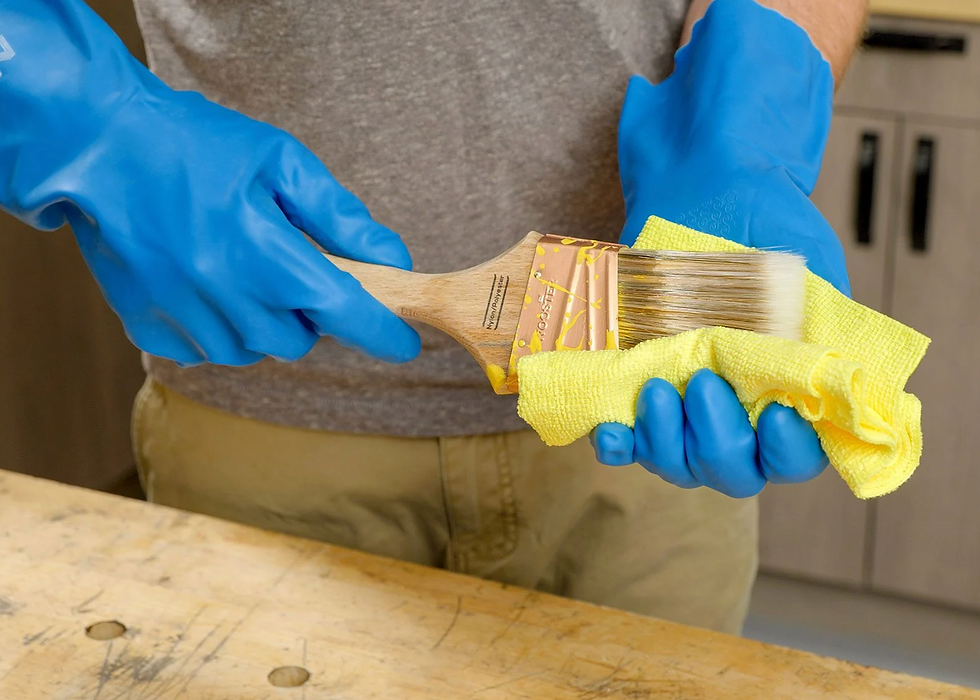Why Cleaning Paint Brushes with Soap and Water After Paint Thinner is Essential
- Ryan Greis
- Dec 10, 2024
- 3 min read
For anyone who uses paint brushes regularly—whether for fine art, furniture restoration, or home improvement—cleaning tools thoroughly is a critical step in maintaining their performance and longevity. While paint thinner is an excellent first step for removing stubborn, oil-based paints, stopping there can do more harm than good. Over time, prolonged exposure to paint thinner can weaken, dry out, and even destroy the bristles of your brushes. Here's why finishing with soap and water is a must.
1. Paint Thinner is Highly Corrosive to Bristles
Paint thinner is a powerful solvent designed to break down tough, oil-based paints and coatings. However, this strength comes at a cost: it’s highly corrosive to natural and synthetic bristles. Leaving paint thinner on your brushes—even for a short time—can dry out the bristles, causing them to become brittle, frayed, or permanently misshapen.
Natural bristles, often made from animal hair, are especially vulnerable to solvents because their organic composition is similar to human hair. Without thorough washing, the thinner strips away their natural oils, leaving them dry and fragile. Synthetic bristles, while more resistant, can still lose their flexibility and soften unevenly, making them harder to control.
2. Soap and Water Restore Bristles and Prevent Deterioration
After using paint thinner to remove paint, washing your brushes with soap and water neutralizes the residual chemicals, halting their corrosive effects. A gentle soap, especially one formulated for artists or craftsmen, cleans and reconditions bristles, helping to restore their suppleness and shape. This is crucial for maintaining precision and control in your work.
Rinsing thoroughly with warm water also ensures any remaining paint thinner is flushed out of the ferrule—the metal band that secures the bristles. When paint thinner is left trapped here, it can cause adhesive failure, leading to loose bristles and a shortened lifespan for your brush.
3. Protects the Ferrule and Handle from Damage
While the focus is often on the bristles, paint thinner can also damage the ferrule and handle. The solvent may seep into the ferrule, weakening the glue that holds the bristles in place. Additionally, thinner can degrade wooden or painted handles, causing cracking, peeling, or swelling over time. Washing with soap and water removes thinner residue before it can cause long-term damage, ensuring your brushes remain sturdy and functional.
4. Avoids Accumulated Damage Over Time
Occasional exposure to paint thinner might not ruin a brush immediately, but the cumulative effects of repeated exposure without proper cleaning can be devastating. Brushes that aren’t rinsed with soap and water after thinner will degrade faster, losing their ability to hold paint evenly or create clean, precise strokes. In some cases, neglected brushes become unusable after just a few projects.
5. Soap and Water Create a Cleaner, Safer Work Environment
Another often-overlooked benefit of rinsing brushes with soap and water is reducing the lingering presence of paint thinner in your workspace. Even after wiping off excess thinner, the fumes can remain on your brushes, exposing you to unnecessary chemical inhalation during your next project. Proper washing eliminates these residues, making your workspace safer and more pleasant.

How to Properly Clean Brushes After Paint Thinner
Begin with paint thinner: Swirl the brush gently in paint thinner to dissolve paint. Avoid smashing the bristles against the container to prevent damage.
Wash with soap and water: Use a gentle soap (like an artist soap bar or dish soap) and warm water to lather the bristles thoroughly. Focus on removing any residue near the ferrule.
Rinse thoroughly: Run water through the bristles until it flows clear.
Reshape and dry: Gently reshape the bristles and lay the brush flat or hang it with bristles pointing down to dry.
A little extra care goes a long way in ensuring your tools remain reliable, effective, and ready for every stroke.



Comments